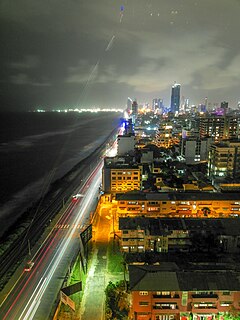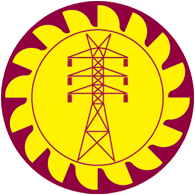
The free-market economy of Sri Lanka is worth $88.9 billion by nominal gross domestic product (GDP) and $291.5 billion by purchasing power parity (PPP). The country has experienced an annual growth of 6.4 percent from 2003 to 2012, well above its regional peers. With an income per capita of 12,811 PPP Dollars or 4,103 nominal US dollars, Sri Lanka is the second wealthiest nation in South Asia after the Maldives and is an upper middle income nation. The main economic sectors of the country are tourism, tea export, apparel, textile, rice production and other agricultural products. In addition to these economic sectors, overseas employment contributes highly in foreign exchange: 90% of expatriate Sri Lankans reside in the Middle East.

Chandrasekera Rohitha Bandara Bogollagama is a Sri Lankan politician and ex Governor of Eastern Province. He was the former Sri Lanka Freedom Party chief organiser for the Kotte Electorate. He had also served as the Cabinet Minister of Foreign Affairs from 28 January 2007 until he was defeated in the General Elections held on 8 April 2010, losing his seat in parliament. He had a long career in law running from 1976 to 1999, before being elected to the Sri Lankan parliament in 2000 from the United National Party, and then crossed over to Sri Lanka Freedom Party
Mohan Munasinghe is a Sri Lankan physicist, academic and economist with a focus on energy, water resources, sustainable development and climate change. He was a Vice-Chair of the Intergovernmental Panel on Climate Change (IPCC), which shared the 2007 Nobel Peace Prize with former Vice-President of the United States Al Gore. Munasinghe is the Chairman of the Munasinghe Institute for Development. He has also served as an honorary senior advisor to the government of Sri Lanka since 1980.

The Ceylon Electricity Board - CEB, is the largest electricity company in Sri Lanka. With a market share of nearly 100%, it controls all major functions of electricity generation, transmission, distribution and retailing in Sri Lanka. It is one of the only two on-grid electricity companies in the country; the other being Lanka Electricity Company (LECO). The company earned approximately LKR 204.7 billion in 2014, with a total of nearly 5.42 million consumer accounts. It is a government owned and controlled utility of Sri Lanka that takes care of the general energy facilities of the island. The Ministry of Power and Energy is the responsible ministry above the CEB. Ceylon Electricity Board (CEB), established by an CEB Act No. 17 of 1969, is under legal obligation to develop and maintain an efficient, coordinated and economical system of Electricity supply in accordance with any Licenses issue

The electricity sector in Sri Lanka has a national grid which is primarily powered by hydro power and thermal heat, with sources such as photovoltaics and wind power in early stages of deployment. Although potential sites are being identified, other power sources such as geothermal, nuclear, peat, solar thermal and wave power are not used in the power generation process for the national grid.
The India – Sri Lanka HVDC Grid Interconnection is a proposed project to link the national grids of India and Sri Lanka. The project involves the construction of a HVDC connection between Madurai in southern India, and Anuradhapura in central Sri Lanka, through the Palk Strait. The link would measure 285 kilometres (177 mi) in length, including 50 kilometres (31 mi) of submarine cables, and would take more than three years to construct. It would be implemented by the Power Grid Corporation of India Limited and Ceylon Electricity Board.
The Hambantota Solar Power Station is the first commercial-scale solar power station in Sri Lanka. The photovoltaic solar facility was constructed in Buruthakanda, in the Hambantota District. The plant is owned and operated by the Sri Lanka Sustainable Energy Authority, a state-run organization responsible for renewable resources.

The Bowatenna Dam is a 100 ft (30 m) high gravity dam at Bowatenna, in the Central Province of Sri Lanka. The dam was built in June 1981, and is used primarily for irrigation. A 40 MW power station is also constructed 5,800 ft (1,800 m) downstream, for hydroelectric power generation.

The Polgolla Barrage, is a barrage built across the Mahaweli River at Polgolla, in the Central Province of Sri Lanka. The barrage is used to increase the volume of water, for transfer to the hydroelectric power station located 8 km (5 mi) north, via penstock.

The Norton Dam is a gravity dam built across the Kehelgamu Oya, which is a major tributary to the Kelani River. The dam is built at Norton Bridge, in the Central Province of Sri Lanka.

Asoka Nalanda Abeygunawardana is a Sri Lankan. He is an Electrical Engineer, environmentalist, social activist and the current Chairman / CEO of the Strategic Enterprise Management Agency at Presidential Secretariat, Sri Lanka

The Public Utilities Commission of Sri Lanka is the government entity responsible for policy formulation and regulation of the electric power distribution, water supply, petroleum resources, and other public utilities in Sri Lanka.
The KCHT Power Station is a municipal solid waste-fired thermal power station currently under construction at Muthurajawela in Sri Lanka. It is being constructed together with the Aitken Spence Power Station, after it won the bid by the Urban Development Authority from a pool of 121 bidders, 19 of which were foreign. Construction of the facility began on 10 August 2017 and will cost approximately US$95 million, with an estimated completion slated for mid-2019.
The Colombo South Waste Processing Facility is a municipal solid waste-fired thermal power station currently under construction at a 10-acre (40,000 m2) site in Karadiyana, Sri Lanka. Together with the KCHT Power Station, it is one of two projects that won the bid by the Urban Development Authority, from a pool of 121 bidders. Construction of the facility began on 23 August 2017 with a completion slated for mid-2019. The estimated cost of the project is approximately US$91 million.
The Sagasolar Power Station is a solar photovoltaic power station built next to the Hambantota Solar Power Station, in Hambantota, Sri Lanka. The solar farm is owned and developed by Sagasolar, a joint venture between LOLC Group and Faber Capital Limited, with 70% debt funded by DFCC Bank, Commercial Bank of Ceylon, and Hatton National Bank. The 10-megawatt facility is expected to generate approximately 19GWh annually for at least 25 years.

The Lanka Electricity Company (Private) Limited, is the largest Electricity distribution company in Sri Lanka. With a market share of nearly, it controls all major functions of distribution and Energy Smart Meter manufacturing in Sri Lanka. It is one of the only two on-grid electricity companies in the country; the other being Ceylon Electricity Board (CEB). The company earned approximately LKR billion in 2018, with a total of nearly 521,982 consumer accounts. It is a government owned and controlled utility of Sri Lanka that takes care of the general energy facilities of the island. The Ministry of Power, Energy & Business Development is the responsible ministry above the LECO. Lanka Electricity Company (Private) Limited (LECO), established by an Companies Act No.17 of 1982 and the Companies Act No.7 of 2007, is under legal obligation to develop and maintain an efficient, coordinated and economical system of Electricity supply in accordance with any Licenses issue

Mahoma Hydroelectric Power Station is a 3.0 megawatts (4,000 hp) mini-hydroelectric power plant, in Uganda.











